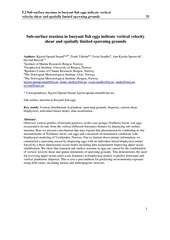Sub-surface maxima in buoyant fish eggs indicate vertical velocity shear and spatially limited spawning grounds
Peer reviewed, Journal article
Accepted version

Åpne
Permanent lenke
https://hdl.handle.net/1956/19189Utgivelsesdato
2018Metadata
Vis full innførselSamlinger
- Geophysical Institute [1185]
Originalversjon
https://doi.org/10.1002/lno.11109Sammendrag
Observed vertical profiles of buoyant particles, in this case pelagic Northeast Arctic cod eggs, occasionally deviate from the vertical diffusion-buoyancy balance by displaying sub-surface maxima. Here we present a mechanism that may explain this phenomenon by combining in situ measurements of Northeast Arctic cod eggs and concurrent environmental conditions with biophysical modeling of Vestfjorden, Norway. Due to limited observational information, we constructed a spawning season by dispersing eggs with an individual-based biophysical model forced by a three-dimensional ocean model including data assimilation improving upper ocean stratification. We show that transient sub-surface maxima in eggs are caused by the combination of vertical velocity shear and spatial limitations of spawning grounds. This demonstrates the need for resolving upper ocean small-scale dynamics in biophysical models to predict horizontal and vertical planktonic dispersal. This is also a precondition for predicting environmental exposure along drift routes, including natural and anthropogenic stressors.
